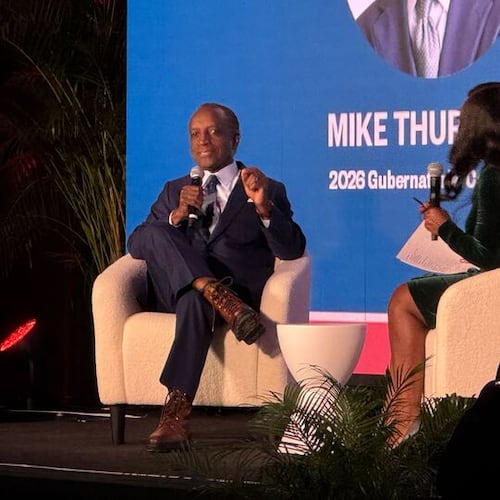A week after Georgia’s primary, tens of thousands of absentee ballots haven’t yet been counted, stalling complete results and leaving some races in limbo.
The sheer number of absentee votes, a Georgia record of 1.1 million, caused much of the holdup. Election workers must sort ballot envelopes, open them, separate ballots and scan votes.
Similar vote counting delays will occur in November's presidential election if high numbers of voters again cast absentee ballots. Most races in last week's primary have already been decided by clear margins, but close elections could turn on absentee ballots.
Difficulties with absentee ballot counting come after an election day marred by hours-long lines in some precincts, especially in densely populated areas with many voters. Lines resulted from social-distancing requirements, precinct closures, poll worker losses and difficulties operating Georgia's new voting equipment, which uses touchscreens to print paper ballots.
On absentee ballots where voters didn’t color in ovals, bipartisan panels have to review them by hand and decide on voters’ intent.
In some cases, lightly marked ballots didn’t register votes at all. Those marked with a check mark or “X” instead of a bubble were most likely to go undetected by the scanners. When scanners miss those votes, they aren’t counted, an issue reported in five counties.
Up to 148,000 absentee ballots still need to be counted before the Friday deadline for counties to certify election results, according to an analysis of state voting records by The Atlanta Journal-Constitution. The AJC compared absentee ballots returned with absentee ballots counted so far in the race for the U.S. Senate to estimate how many remain.
>>RELATED: Election fiasco reveals flaws with Georgia's new voting system
>>RESULTS: Georgia election results
>>PHOTOS: Georgia voters struggle with long lines, new equipment
“Delays in counting absentee ballots are primarily caused by the unprecedented surge in absentee ballots,” said Gabriel Sterling, the statewide voting system implementation manager. “Scanning the large volume of absentee ballots required careful tracking if later review is required.”
It’s not unusual for absentee ballots to need further review. But this election was different because so many more voters used absentee ballots, and election officials used ballot scanners that came with Georgia’s new $104 million voting system.
The number of ballots needing a second look was especially high in Macon-Bibb County, where scanners flagged over half of absentee ballots where voters’ intent wasn’t clear in at least one race, said Mike Kaplan, the chairman for the county’s elections board. He said 9,800 absentee ballots needed review out of about 18,450 cast.
“The majority of problems with absentee ballots were people who were voting that way for the first time,” Kaplan said. “It’s a learning experience for all of us. Next election, just fill in the oval.”
Kaplan said the process worked, and absentee ballots were scrutinized to ensure votes were recorded accurately. It’s unclear why Macon-Bibb County had so many questioned absentee ballots.
In Fulton County, scanners identified about 4% to 5% of ballots in need of human review, Elections Director Rick Barron said.
“The system is more sensitive than the old system when it comes to the ballots that go unaccepted by the scanners,” Barron said. Fulton had up to 8,000 uncounted absentee ballots.
But the secretary of state’s office said absentee vote counting standards are identical to Georgia’s old voting system.
Vote scanners are programmed to set aside absentee ballots for review if they have a race with 14% to 28% of an oval filled, Sterling said. Votes with 13% or less of an oval filled are considered a “no mark.” The oval itself is counted as 5% of the total needing to be completed.
“The potential for ambiguity is inherent to hand-marked paper ballots,” Sterling said. “This doesn’t happen with (computer-printed) paper ballots. Voter intent is clear.”
Thousands of absentee ballots cast in Cobb County needed to be inspected by human eyes to resolve discrepancies, Cobb Elections Director Janine Eveler said. There were as many as 8,170 outstanding ballots in Cobb as of Tuesday afternoon.
“That always happens,” Eveler said. “If there are stray marks that are considered possible overvotes, the vote review panel adjudicates what the voter intended.”
Gwinnett County election officials said Monday that they had counted all absentee ballots except for those that optical scanners flagged or needed verification of voter information. As many as 4,800 absentee ballots remain in Gwinnett, according to the AJC’s estimates.
DeKalb County voting records indicate about 3,000 absentee ballots remaining.
“Some people put an ‘X’ in there, some people put a circle around it. Those kinds of things, we are are having an issue with,” said Samuel Tillman, the chairman for the DeKalb Board of Elections.
Besides ballots needing human review, another issue arose when scanners didn’t read votes at all in some races.
Members of vote review panels in Athens-Clarke County and Morgan County, whose job is to look at ballots to decide voter intent, said they found that ovals filled in with check marks sometimes didn’t show up, nor were those votes flagged by scanning machines. Those votes weren’t counted unless the panels saw an uncounted mark on the ballot and then agreed to count it.
“The computer was just skipping it because it hadn’t recognized anything wrong,” said Jeanne Dufort, a Democrat on Morgan County’s vote review panel. “We were all shocked. We clearly and quickly said: ‘That’s wrong. Those are votes.’ ”
About 20 votes on scanned ballot images weren’t recorded, Dufort said.
In Athens, between 30 and 50 ballots, out of 300 set aside for review, had races on them where votes weren’t counted even though they had been marked, Athens Board of Elections Chairman Jesse Evans said. The board voted Monday to recount ballots in some precincts and look for votes that the machines missed.
“Every vote should be counted,” Evans said. “That’s our job.”
Counting absentee ballots
- Election workers verify voter information and signatures on ballot envelopes.
- Absentee ballot envelopes are opened and separated from ballots inside to protect voter secrecy.
- Workers feed absentee ballots through optical scanners, which read voters' bubbled-in choices.
- Optical scanners flag ambiguous marks for human review.
- Bipartisan voter review panels look at ballots or ballot images to decide voter intent in questioned races.
About the Author
Keep Reading
The Latest
Featured





